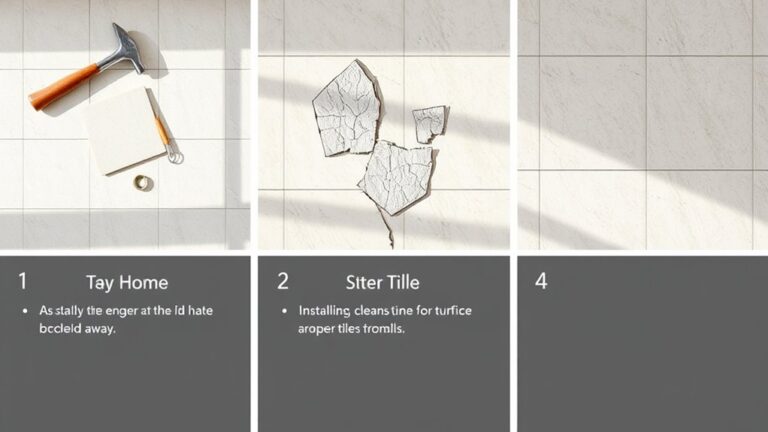Radiant heated floors provide you with even warmth and can greatly enhance your comfort, especially in colder areas of your home. They operate more efficiently than traditional heating systems, potentially lowering your energy bills. However, the initial installation costs are higher, and you may face challenges like increased floor height and access issues for repairs. Maintenance is usually minimal, but it's important to check for leaks regularly. Balancing the benefits and drawbacks can guide your decision. Keep exploring to find out more about their installation options and how they can impact your home's environment.
Overview of Radiant Heated Floors
When it comes to creating a cozy and inviting home, radiant heated floors can be a game changer. These innovative heating systems use electric wires or hydronic pipes installed beneath your floor coverings to provide even warmth throughout your space. Imagine stepping onto a warm floor on a chilly morning – it's a luxury that enhances your comfort every day.
One of the standout benefits of radiant heated floors is their energy efficiency. They operate 20-25% more effectively than traditional forced-air heating systems, which translates into lower operational costs. Plus, these systems can last over 20 years with minimal maintenance, often backed by warranties that reach up to 25 years.
The installation process can vary depending on the type you choose, but it's generally straightforward. Whether you prefer tile, laminate, hardwood, or vinyl, radiant heated floors are compatible with various flooring types, giving you plenty of design flexibility.
However, it's crucial to evaluate the pros and cons. While the comfort and efficiency are undeniable, the initial installation cost can be higher than traditional heating systems. Additionally, if you decide to change your floor coverings later, you'll need to assess the compatibility of your new choices with the radiant system.
Benefits of Radiant Heating
Radiant heating offers you a cozy, uniform temperature throughout your home, eliminating those annoying cold drafts. Not only is it energy-efficient, leading to lower bills, but it also creates an allergy-friendly environment by reducing dust and allergens. With these benefits, radiant heated floors can be a smart choice for comfort and health.
Uniform Temperature Distribution
One of the standout benefits of radiant heating is its ability to provide uniform temperature distribution throughout a room. Unlike traditional heating systems, which often create hot and cold spots, radiant floor heating eliminates those frustrating drafts, ensuring a consistent and comfortable environment. You'll appreciate how the heat radiates evenly upward from the floor, making every corner of your space feel inviting.
The floor temperature typically ranges from 80°F to 85°F, which is perfect for walking barefoot. Imagine stepping onto a warm floor on a chilly morning—it's a comfort you'll love. This uniform heating not only enhances your experience but also promotes a sense of freedom in your home, allowing you to enjoy every area without worrying about temperature fluctuations.
Moreover, radiant heating systems are designed to minimize energy waste, leading to impressive energy efficiency. By maintaining a stable environment without excessive energy use, you can enjoy a cozy atmosphere while potentially reducing your energy bills. With radiant floor heating, you're not just investing in a heating system; you're embracing a lifestyle of comfort and efficiency.
Energy Efficiency Benefits
Energy efficiency is a standout feature of radiant heated floors, making them a smart choice for homeowners looking to lower their energy bills. Radiant floor heating systems operate 20-25% more efficiently than traditional forced-air systems, thanks to their ability to deliver consistent warmth with less energy. By maintaining lower temperatures—typically around 29°C (85°F)—you can enjoy significant energy savings compared to the higher settings required by conventional radiators.
These systems work by heating surfaces and objects directly rather than just warming the air, which minimizes heat loss and creates a cozy atmosphere in your home. The use of programmable thermostats further enhances energy efficiency, allowing you to schedule heating during off-peak hours and potentially reducing operating costs.
Additionally, with reduced air circulation, radiant heating not only lowers energy consumption but also promotes a healthier indoor environment by minimizing dust and allergens. If you're seeking freedom from high energy bills and an efficient heating solution, radiant heated floors might just be the ideal choice for your home.
Allergy-Friendly Environment
Having an allergy-friendly home is a priority for many people, and radiant heated floors can help achieve that goal. Unlike traditional heating methods, radiant heating systems minimize air circulation, which considerably reduces the movement of dust and allergens. This creates a healthier indoor environment, especially beneficial for allergy sufferers.
With less reliance on forced-air systems, you won't have to worry about dust being stirred up, promoting a cleaner atmosphere that's easier on your respiratory health. The non-allergenic nature of these systems also helps maintain consistent humidity levels, avoiding the dryness often associated with conventional heating.
By providing uniform warmth from the floor up, radiant heating reduces the likelihood of cold drafts, which can worsen allergy symptoms. Studies show that homes equipped with radiant heating experience lower allergen levels, contributing to improved overall indoor air quality.
In essence, if you're looking for a way to enhance your living space while keeping allergies at bay, radiant heated floors offer a practical solution. They not only provide comfort but also foster an environment that supports your health and well-being.
Drawbacks of Radiant Heating
When reflecting on radiant heating for your home, it's crucial to weigh the drawbacks alongside the benefits. While radiant heated floors can create a cozy atmosphere, they come with significant disadvantages you should know about.
| Drawbacks | Description |
|---|---|
| High Installation Costs | Costs can range from $6 to $24 per square foot, making it pricier than traditional systems. |
| Increased Floor Height | Expect your floor height to rise by about an inch, potentially affecting door clearance and furniture arrangement. |
| Disruptive Installation ProcessInstalling these systems often requires removing existing flooring, leading to temporary inconveniences. | |
| Limited Repair AccessIf something goes wrong, accessing underfloor components can be tough, often needing floor coverings removed first. |
You'll find that the disruptive installation process can complicate retrofits and create chaos during renovations. Plus, if your radiant heating system experiences a breakdown, the potential for damage can lead to costly repairs due to the limited access under the floor.
With all these factors in play, it's crucial to evaluate if the comfort of heated floors is worth the trade-offs. Understanding these disadvantages of radiant floor heating can help you make an informed decision that's best for your lifestyle and home.
Installation Process and Costs
Installing radiant heated floors can be a transformative choice for your home, but understanding the process and associated costs is essential. The installation process can vary considerably based on whether you choose electric or hydronic systems. Electric systems, typically costing between $10 to $20 per square foot, are easier to install and can often be tackled as a DIY project. You'll roll out heating mats or cables, secure them, and install sensors, ensuring everything functions correctly before connecting to a thermostat.
On the other hand, hydronic systems, ranging from $6 to $20 per square foot, require professional installation due to their complexity involving boilers and pumps. This added complexity can inflate your costs, but the potential for energy efficiency—20-25% more than traditional forced-air systems—might make it worthwhile in the long run.
Before you begin, you'll need to remove any existing flooring, and keep in mind that the new flooring will add about an inch to your space's overall height, which could affect door clearance. While the upfront costs of radiant heating can be high, the promise of lower heating bills and enhanced comfort might just be the freedom you're looking for in your home. Ultimately, weighing these factors will help you make an informed decision that aligns with your vision for an efficient, cozy living space.
Types of Radiant Heating Systems
When considering radiant heating systems, you'll typically come across three main options: electric, hydronic, and air-heated systems. Electric systems are often easier to install and work well in smaller spaces, while hydronic systems are better suited for larger areas and whole-home heating. However, air-heated systems aren't commonly used in homes due to their inefficiency, making the first two options your best bet.
Electric Radiant Heating Systems
Utilizing electric radiant heating systems can transform the comfort of your home, especially in smaller spaces like bathrooms. These systems work by installing electric cables or mats underneath the flooring, efficiently heating your home while keeping the air quality intact.
Here are some benefits you might appreciate:
- Quiet Operation: Unlike forced-air heating, electric systems operate silently, creating a peaceful atmosphere.
- Flexibility in Temperature Control: You can easily adjust the heat for individual rooms, ensuring comfort where you need it most.
- Easier Installation: With no need for plumbing or boiler systems, they're ideal for retrofitting existing homes, making them a popular choice for DIY enthusiasts.
While installation costs typically range from $8 to $24 per square foot, you might find that the convenience and comfort outweigh the initial investment. Although electric radiant heating systems can have higher long-term operating costs compared to other options, their ability to provide targeted heat and adaptability in smaller areas makes them a worthy consideration. If you're looking for a straightforward way to enhance your living space, these systems could be just what you need.
Hydronic Radiant Heating Systems
If you're considering radiant heating options for your home, hydronic radiant heating systems are another compelling choice worth exploring. These systems circulate heated water through plastic tubing beneath the floor, making them highly efficient for larger spaces and whole-home heating. While installation costs can range from $6 to $20 per square foot, they offer notable long-term savings on energy bills.
One major advantage of hydronic systems is their ability to facilitate zone heating, allowing you to customize temperatures in different areas based on your needs. Plus, if you already have a water heater, you can leverage existing infrastructure to improve cost efficiency.
Here's a quick overview:
| Feature | Benefits | Considerations |
|---|---|---|
| Energy Efficiency | Lower energy bills | Higher initial installation costs |
| Zone Heating | Customized comfort | Complex installation requiring professional services |
| Longevity | Lasts over 20 years | Maintenance may be necessary |
| Heated Water | Works well with existing systems | Requires a boiler and pump |
Air-Heated Radiant Systems
Air-heated radiant systems are rarely chosen for residential heating due to their inefficiency and high operating costs. These systems rely on heated air circulating beneath the floor, but this approach struggles to maintain consistent warmth across larger spaces. As a result, many homeowners find them less effective compared to more popular options like electric and hydronic systems.
When considering air-heated radiant systems, keep in mind:
- Complex installation: The initial setup often involves intricate ductwork, making installation a challenge.
- Energy inefficiency: These systems are less energy-efficient, leading to higher long-term operational costs.
- Limited feasibility: Due to their limitations, air-heated systems are often overlooked for modern home heating solutions.
In the quest for freedom and comfort in your home, it's crucial to weigh these factors carefully. While the concept of air-heated radiant systems may sound appealing, the reality is that their inefficiency and high operating costs can restrict your heating options. Opting for more energy-efficient systems could save you money in the long run, ensuring your home remains a cozy haven without breaking the bank.
Recommended Areas for Installation
When considering where to install radiant heated floors, you'll find that certain areas really shine with this type of heating. Radiant floor heating is perfect for bathrooms, where stepping out of the shower onto a cold tile can be jarring. With heated floors, you'll enjoy that comfortable, warm floor underfoot, making those chilly mornings much more pleasant.
Kitchens also benefit considerably from this heating system. If you spend hours preparing meals, nothing beats a warm floor to ease the strain on your feet and back during those colder months. You'll appreciate how much more enjoyable cooking becomes when your feet are cozy.
In bedrooms, radiant heating creates a snug atmosphere that enhances your sleep quality. Imagine slipping into bed after a long day, with your feet warmed by the floor. It's a simple luxury that makes a world of difference on those frosty nights.
Don't overlook garages, either. With radiant heated floors, these spaces can be transformed into usable year-round areas. You can prevent frost buildup, making it easier to enter and exit your vehicle without the hassle of icy floors.
Technology and Control Options
Radiant heated floors not only provide comfort in your home but also come with advanced technology that enhances their functionality. With smart thermostats, you can program your heating settings to suit your lifestyle, which boosts heating efficiency while keeping operational costs in check. Imagine waking up to a perfectly warmed floor, all thanks to a schedule you set in advance!
Here are a few standout features you might enjoy:
- WiFi-enabled systems: Control your heating from anywhere using your mobile device, giving you ultimate freedom and flexibility.
- Temperature customization: Set different heat levels for various rooms based on usage patterns, ensuring comfort where you need it most.
- Energy monitoring: Track your energy consumption to optimize heating schedules and reduce costs, helping you make informed decisions.
Additionally, integrating your radiant heating with home automation systems allows seamless control alongside other smart devices. Want to warm your living room before you arrive? Just a few taps on your smartphone, and you're set! This level of automation not only adds convenience but also contributes to a more efficient home.
Maintenance and Longevity
How can you guarantee your radiant heated floors last as long as possible? The key lies in understanding the maintenance and longevity of your radiant floor heating system. With a lifespan of 20 years or more, many systems come with warranties extending up to 25 years. To keep yours running smoothly, minimal upkeep is required. Regularly check for leaks or electrical issues, and you'll be on the right track.
If you've got hydronic systems, make certain proper insulation around the pipes. This prevents heat loss and enhances efficiency, which in turn prolongs the system's life. Electric systems are often simpler to repair, but when repairs are necessary, it's crucial to connect with experienced professionals. Accessing heating elements can be tricky post-installation, and quality repairs matter.
Consider using a digital ohmmeter to test the heating elements periodically. This proactive approach can help you catch potential issues before they escalate. While repairs can be infrequent, acknowledging their importance guarantees your system remains effective and efficient.
Ultimately, the longevity of your radiant floor heating depends on your commitment to maintenance. By staying informed and proactive, you can enjoy the cozy, consistent warmth your system provides for years to come. So, embrace the freedom of radiant heating, knowing that with a little care, your investment will pay off in comfort and reliability.
Economic and Environmental Impact
When considering radiant heated floors, it is crucial to weigh the initial installation costs against long-term energy savings. You could save 20-25% on heating bills due to their efficiency, which might make that upfront investment more appealing. Plus, many states offer incentives that can help offset those costs, making it a practical choice for both your wallet and the environment.
Installation Cost Considerations
Installing radiant heated floors can seem like a hefty investment, with costs ranging from $6 to $24 per square foot depending on the system you choose. Electric systems typically fall between $8 to $24 per square foot, while hydronic systems can range from $6 to $20 per square foot. The initial investment for hydronic installations can be particularly high due to the need for a boiler and additional plumbing.
However, it's worth evaluating the long-term benefits. Radiant floor heating systems are 20-25% more energy-efficient than traditional forced-air systems, potentially lowering your heating bills over time. Here are a few key points to reflect on:
- Many states offer financial incentives for energy-efficient upgrades.
- The average daily operating cost ranges from $1.50 to $7, depending on your region and system efficiency.
- While the upfront costs might be intimidating, the savings can add up.
Ultimately, weighing the installation costs against potential savings and incentives will help you make a more informed decision about radiant floor heating for your home.
Energy Efficiency Benefits
Radiant heated floors offer a compelling blend of economic and environmental benefits that can greatly enhance your home's efficiency. When you choose radiant floor heating, you're opting for a system that's 20-25% more energy-efficient than traditional forced-air heating systems. This means lower operational costs and reduced energy consumption, which is great for your wallet.
One key advantage is the ability to maintain consistent warmth at lower temperatures—around 29°C—compared to conventional radiators that heat to 65-67°C. This not only reduces energy waste but also improves overall efficiency. The use of thermal mass, like concrete or tile, allows the system to retain heat longer, maximizing your energy savings.
You can also program thermostats to align with your heating schedules, ensuring you only use energy when you need it. This feature further enhances energy efficiency and minimizes unnecessary energy usage. Plus, by reducing your reliance on fossil fuel-based heating sources, radiant heating considerably lowers your carbon footprint, helping you align with sustainability goals. Embracing radiant heated floors means embracing a smarter, eco-friendly way to keep your home warm.
Common Misconceptions About Radiant Heating
Despite the growing popularity of radiant heated floors, several misconceptions persist that can deter homeowners from evaluating this efficient heating option. Many folks think radiant floor heating is just for luxury homes, but it's becoming a practical choice for a variety of residential settings due to its comfort and energy efficiency.
Here are some common myths that need debunking:
- Installation is complicated: Contrary to belief, you can easily install radiant systems, especially electric ones, as DIY projects or integrate them into existing spaces.
- High operating costs: Many assume the cost to run these systems is exorbitant. In reality, radiant heating can be 20-25% more energy-efficient than traditional forced-air heating options, often leading to lower bills.
- Limited flooring compatibility: It's a misconception that radiant heating only works with specific types of flooring. In fact, you can install radiant systems under tile, laminate, hardwood, and vinyl.
Another important point to evaluate is the ability to adjust temperatures. Modern systems now come equipped with smart thermostats, allowing you to create custom comfort settings without the worry of cold spots in your home. When weighing your heating options, keep these realities in mind to make an informed decision about whether to install radiant heating in your space.
Frequently Asked Questions
What Are the Cons of Radiant Floor Heating?
When considering radiant floor heating, you might face several cons. The installation costs can be high, and you'll need to think about flooring compatibility. Maintenance requirements can complicate things, too, as accessing the system often means removing flooring again. Some system types may create uneven heat distribution or noise levels that disrupt your comfort. Plus, without careful management, you could experience overheating, making energy efficiency a concern in the long run.
What Are the Disadvantages of Radiant Heaters?
When considering radiant heaters, you'll face installation challenges that can disrupt your space, cost considerations that might strain your budget, and maintenance requirements that complicate repairs. You may also notice issues with heat distribution, leading to uneven warmth. Plus, verify system compatibility with your existing setup. Finally, think about the environmental impact of energy efficiency—some systems may not align with your sustainability goals, limiting your freedom to choose the best option.
What Is the Downside of Underfloor Heating?
When considering underfloor heating, you'll face challenges like high upfront costs and installation complexity. You might also need to think about the maintenance requirements, as accessing the system for repairs can be tricky. While energy efficiency is a plus, temperature regulation can be an issue if the system isn't compatible with your flooring options. All these factors can impact your overall comfort and freedom in making design choices for your space.
What Is the Life Expectancy of Radiant Floor Heating?
The life expectancy of radiant floor heating systems can exceed 20 years with proper installation and maintenance. You'll want to take into account the installation process, as quality matters. Energy efficiency and cost comparison between system types—like electric and hydronic—also play a role. Maintenance requirements, such as checking for leaks, are vital. Finally, verify your chosen system is compatible with your flooring to maximize heating zones and overall performance.




